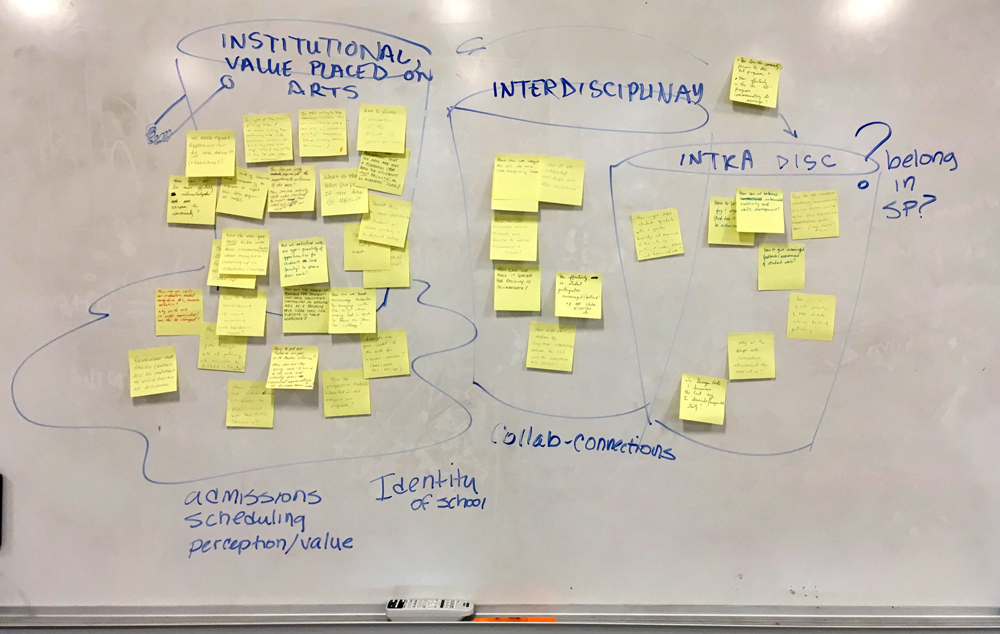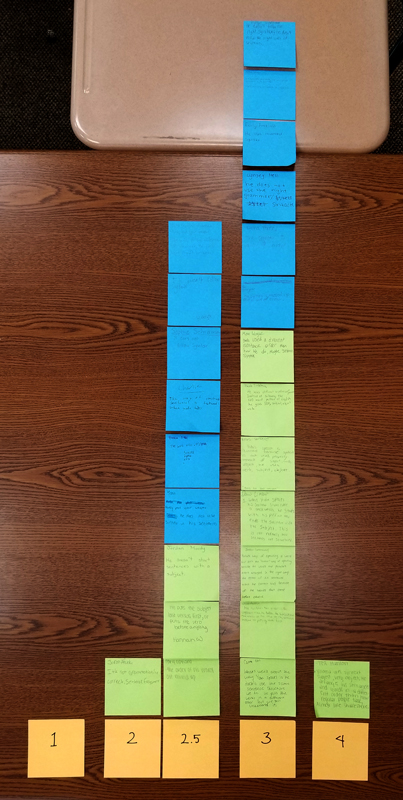Reimagining the Quiz with Sticky Notes
Here’s a question I’m always asking myself: how can I steal methods from design to improve my classroom work?
Well, here’s one method we can steal from the discipline of design. The sticky note session. Folks who follow the methods of Tim Brown, the Stanford dSchool, and anybody who chants the phrase “design thinking” with reverence will be familiar with the ubiquitous use of sticky notes to facilitate brainstorming.
One way designers use stickies is to analyze. To create columns on the wall that everyone can assess. Or categories that can be refined by moving elements around. Stickies are great because they become little stand-ins for ideas, giving concrete presence to abstract thoughts as a designer or group of designer seeks to manipulate, combine, separate, and schematize those thoughts.
Stickies in Education Brainstorming
Check out Norman Tran’s Design Thinking Playbook for Change Management in K12 Schools. It’s a good introduction into how to apply design methods to curriculum development. Or other school-wide initiatives.
Here’s an example of how I’ve borrowed from Tran’s approach. My colleagues and I adapted his “Sprint Topic Brainstorm” method to define key questions about our Arts curriculum. We spent about 20 minutes reading over the questions and moving the stickies around the board. We found that, when we tried to organize the questions into “buckets,” one bucket “spilled” and two other buckets overlapped:

In short, analyzing the questions in this way led us to construct an overview of our curricular priorities: how they ranked and how they related. We couldn’t have done it effectively, within the time constraints, without sticky notes.
Stickies for Visualizing Assessment Data
But what about the classroom? What about using stickies for assessment? What if we could visualize and manipulate students’ answers to quiz questions in the same way? Could we turn quizzes into a kind of brainstorming?
Suddenly, the results of an assessment become not just data points in the gradebook. They become a visual way to work with your students as a team — work with them toward a greater clarity of communication of whatever concept you are trying to get them to own.
I’ve tried other ways to make my assessments data-driven. But I get bogged down quickly. Or I can only present my results and say something about the average score, or percentiles. These generalized pieces of feedback don’t help my students learn. They tell them where they are, so they can be anxious about the difference between that and where they want to be. Not really a goal of mine.
Here’s what using stickies can do, though. Making the numbers quickly visual, by scoring the quizzes on-the-fly — as soon as students hand them to you — and sticking them up on the board as a histogram — Wow!
It still gives you and your students immediate feedback on how the class as a whole is doing, and where an individual student finds themself in the spread.

But — way more importantly — it also gives you talking points. If for example, you compare, out loud, all the “half-credit” answers, you’re leveraging your quiz as review and reinforcement. And that, my friends, is good instructional design: assessment and feedback immediately parlaying into socially constructed reinforcement. My hunch is that, for most students, this is a more effective form of feedback than checks and X’s on their quizzes. Or even brief written notes, which they often can’t decode.
Example: a One-Question Quiz on Syntax
When I tried this activity, I used a one-question quiz. One-question quizzes, in my mind, are the best quizzes. The only quizzes, really, you could successfully leverage in this way without it becoming a time-sink in class. If you insist you need a multi-question quiz, then I would say only do one of your four or ten questions on the sticky note — the one you are most interested in. Whose answers you most want to analyze with your students.
Anyway, I had just taught a lesson on syntax. We defined it, and its relationship to grammar. For the quiz the next day, I asked one question: “What is wrong with the way Yoda speaks?” I gave examples: “Away put your weapon.” “Help you I can.” I was looking for them to tell me something accurate or at least convincing about his syntax.
My four-point rubric basically translates to this:
1 = unfamiliar with concept
2 = familiar with concept
[2.5 = partial competence with concept]
3 = can competently apply concept
4 = fully owns concept
To aid the visualization, I used a different color sticky for each class–green for Period 4, blue for Period 6.
We talked a bit about the answers earning 2.5, and discussed the main difference between those and the answers earning a 3. Many 2.5’s said Yoda wasn’t using syntax. Many 3’s said he was using syntax, though improperly. We discovered that this was an important distinction for understanding what syntax was.
In my mind, that one takeaway made the whole exercise worthwhile.
I’d like to close by suggesting that the histogram/discussion is only one activity you could do with a sticky quiz. And I’d love to hear what some of your ideas are. Drop me a line!